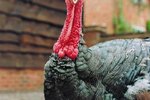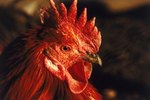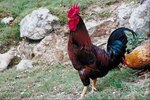Chicken eggs are delicious, but the poultry view of egg-laying is decidedly reproduction focused. While egg-laying doesn't require a rooster on the scene, fertilization for eventual chicks does. The rooster-hen mating ritual is a bizarre and wholly unlikely act. From unique behaviors to a trying physicality, the rooster's role in mating is a challenge he will overcome many times a day.
What Roosters Do
While a rooster's place in a flock surely includes mating, his role encompasses a few more requirements. For starters, a rooster provides protection for his brood, a minimum of 8 to 10 hens that one rooster chooses to travel with and care for. With a larger body size, pair of sharp leg spurs and distinctive crow, the rooster appears built for predator protection. Roosters also aid in finding food, which in a pastured chicken's diet can include anything from clover to small rodents, crowing to call hens over to a food source or sometimes even delivering a morsel to a hen he aims to mate with.
Behavioral: The Mating Dance
A rooster's mating ritual can be a fascinating thing to watch. Many roosters begin mating with a wing drag, a move wherein he fans his wings to display feather size and coloration, often bristling the hackle feathers around his neck for added effect. The wing drag will either precede or coincide with a dance that circles from one side to a hen's front, then around to her hind area, where he'll position himself for sex. In this dance, he'll duck his head to raise tail feathers and lift his legs in a distinctive, prancing gait. If the hen doesn't move away in rejection, he'll begin the sexual encounter.
A Challenging Anatomy
The roosters' reproductive anatomy differs from many other animals, chiefly due to the bird's lack of a penis or other external genitalia -- everything's concealed. The rooster's sexual organ is called a papilla, a small bump inside his cloaca from which semen exits. To mate, a rooster climbs onto the back of a hen, standing on the hen's back and using his wings maintain balance, and forcefully touches his cloaca to hers in what's known as a cloacal kiss. Semen is transferred from the rooster to the hen in a matter of seconds, after which the rooster dismounts, shakes his head and walks away.
Not a Perfect Animal
While roosters are valuable for their protective and reproductive contributions, they are not necessarily easy creatures. Their mating habits can damage hens' backs and/or heads, as their talons and beaks tear away feathers and injure the skin beneath. Durable chicken saddles that fit on a hen's back are available to protect against damage. Chicken keepers must be careful not to overpopulate a flock with roosters. While multiple roosters can coexist in one flock, enough hens must be present for each rooster to establish a brood, lest bloody battles become a persistent problem. Roosters over age 3 may begin to show reproductive decline, though there's no fixed age roosters stop mating.
References
Photo Credits
-
Thinkstock/Stockbyte/Getty Images
Writer Bio
Rodney Wilson is owner and manager of Goldfinch Farm in central Kentucky, where he oversees veterinary and management practices for a diverse group of animals, from dogs and cats to pigs and chickens. He's written professionally since 2001, with articles appearing in such publications as The Cincinnati Enquirer, CiN Weekly, Baby Guide and Akron Life.





